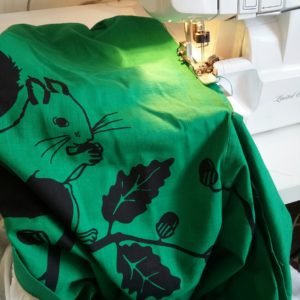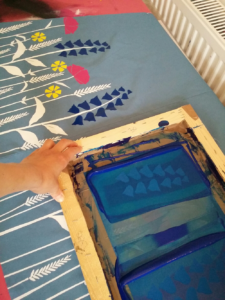We get a lot of questions about the best way to lino print onto fabric. Which ink should I use? Should I use a roller? Will it be washable? Will it change
the handle of the fabric? These are all questions to which we wanted to know the answers – not just for all of our lovely customers, but for our own
work too!

We have tested four different inks on
cotton , each using the same
lino block , to give you the methods available for creating beautiful block printed fabric!
All of the prints below were made on a slightly padded surface. This is a really important tip when printing onto fabric as it makes it easier to get an
even print. We use an old blanket stretched over a board then covered with cotton. Too hard a surface and you will get an uneven print, too soft and
you will get a messy print so experiment with what you have at home.
We used the block made in our
last blog project !

1:
Versacraft Fabric Inks Pads
We sing the praises of these humble little ink pads a lot and Handprinted. We love how quick, easy and tidy it can be to print onto fabric, paper and so
many other surfaces.

We tested
Versacraft Poppy Red.

Inking up a block is so easy and mess-free. I like to have the block face up and use the pad press all over. This way you can see how much ink you are
putting on and where it’s going.

Press the block onto your fabric, making sure to press all over.

Versacraft prints fairly evenly and easily. The ink pad used for this print has been used a lot in our studio and still has a lot of ink left. A brand
new ink pad would produce a slightly stronger colour.
Iron to fix the prints when dry and the fabric will be washable and not fade. The handle of the fabric doesn’t change at all.
The prints are fairly even but not always completely consistent. I prefer to use
Versacraft ink pads with a softer printing material such as Mastercut which is perfect for stamping.
2.
Caligo Safewash Relief Pri
nting Inks and a
roller

We are testing Caligo Process Magenta Relief Ink using a
Soft Rubber Roller . The ink is oil based but water soluble (you can wash up with water and soap or a baby wipe) – the best of both worlds!

This ink rolls out beautifully into a lovely tacky square on a glass slab.

The ink rolls out easily onto the block. We use this ink for relief printing all the time and love the way it works with lino. You can mix in some extender
if you would like a more transparent ink that goes a little further.


Caligo inks are designed to print onto paper – they are not made for printing onto fabric. However, we have used them to print on fabric before and will
again! They print beautifully, evenly and with good colour. The downside to using these inks is that they take a day or two to properly dry. Once dry
they are washable and hold their colour very well! The ink leaves the fabric soft with only a small change to its handle. (Please test this ink on
your fabric for drying time and wash-fastness before you undertake a large project as this ink was not originally designed for use on fabric and results
may differ.)
3.
S
peedball Block Printing Inks for Fabric and a roller

We’re using the Red from the multi-pack kit but they can also be bought individually in larger sizes. We are using it with the same soft rubber roller
as before.

The inks rolls out well. It’s a little less tacky than the Caligo because it is water based.

It rolls out onto the block well.


The colour is strong and the prints are neat but a little less even than the Caligo and the Versacraft. Because this ink is designed for block printing
onto fabric it becomes washable without losing colour after being left for approximately one week to air dry. The handle of the fabric barely changes at all.
4.
Speedball Fabric Screen Printing Ink and a
sponge roller

This is a technique that we are always suggesting to our customers. The screen printing ink is more economical, completely washable, colour fast and easy
to use. We are using Speedball’s Red ink but
Permaset Aqua inks work just
as well. A sponge roller is necessary for these inks as they are much looser and more slippy. An ordinary roller would just slide around in the ink
and not put down an even layer.

The ink rolls out easily with a sponge roller if you don’t press as hard as you normally would with a hard roller. You’ll need to spoon out more ink than
you would with a block printing ink as the sponge absorbs some.

A firm pressure transfers the ink well onto the block.

These prints can be a little bubbly textured where the sponge has been used – seemingly the only down side to this method.

The prints are bright, washable after ironing and change the handle of the fabric not one bit.
All the prints together:

(Although the inks were all red, the shades differ as seen above).
The
S
peedball Screen Printing Ink prints the boldest and brightest, is the most washable, does not change the handle of the fabric and is the most economical
(a 236ml pot of the ink will cost under £10 and last a very long time). you will need to use a sponge roller with this ink as a hard roller will
slip.
The
Caligo Relief ink produces
the most even print with a consistent colour, rolls out in the most satisfying way possible and washes well. It does however take a long time to dry
and leaves a very very slight stiffness to the fabric. (Please test this ink on your fabric for drying time and wash-fastness before you undertake
a large project as this ink was not originally designed for use on fabric and results may differ.)
The
Versacraft Ink Pad s are by far the easiest to use, require the least equipment and a spend of only £5.50. The prints are a little less bold when
using lino rather than a stamping material such as Mastercut and the method may become a little tedious if printing a large area of fabric (I’m currently
about a third of the way through printing a duvet cover using this method which looks lovely but is taking a very long time! I expect I will have to
keep my duvet in the living room so that more people might see it).
The Speedball Block Printing Inks for Fabric serve their purpose very well, producing a strong colour and soft handle with good wash-ability. They do work out a little more pricey than the Screen
Printing Inks though, at the same price for a smaller quantity.
We hope our testing helps you to discover the right method for your project!


































.JPG)









.JPG?Action=thumbnail&algorithm=fill_proportional&width=789)






























